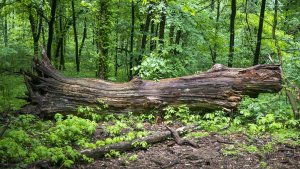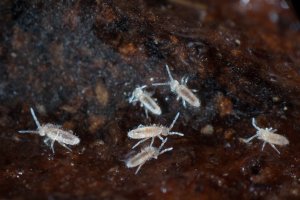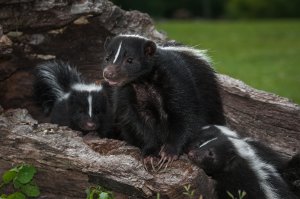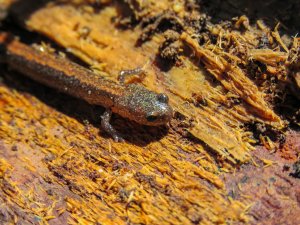Life Under a Log
May 3, 2023
By Annica Brocker, Park Interpreter
Life depends on plants to survive. Without photosynthesis, the process where plants use sunlight and carbon dioxide to create oxygen and sugars, food and air would not exist. Trees, being the largest plants in Michigan and in the world, are important producers of oxygen and food for animals as small as an ant to as large as a bear. In Southeast Michigan, over 450 species of butterflies and moths alone rely on oak trees as a plant for their caterpillars to grow and develop on. While they are alive, trees are undoubtable an incredible asset for a healthy environment. When trees die, their importance does not decrease; it only changes.

When trees die from weather events, such as the severe ice storms this past winter, infections from insects or diseases, or from human impact, the trunk of the tree can stand for some time before it eventually falls. Standing dead trees, often called “snags”, are great habitat for many animals from nesting birds to overwintering squirrels. Fallen dead trees, or logs, offer the same and are a lot easier for smaller animals to access who may not be exceptional fliers or climbers. Logs are excellent examples of microhabitats, or a habitat found within a larger habitat. Within the forests of Stony Creek Metropark, fallen logs create a damp, dark shelter at odds with the brighter, open space under the living trees’ canopies.
Logs are used by a wide variety of animals in a wide variety of ways. Detritivores, animals that feed on dead organic matter or detritus, are naturally drawn to rotten logs like a buffet. These detritivores include springtails (which are smaller even than a grain of rice), termites, and isopods (also known as roly-polies or pill bugs). Without detritivores, dead and fallen trees would completely cover the ground and pile on top of each other. Though small, mighty detritivores help break down trees into nutrient dense soil for new plant growth to flourish in.

Detritivores, unfortunately for them, are not the only animals to rely on logs for food. Many predators and insectivores, animals that feed on insects and other invertebrates, come to logs to feed on… you guessed it: detritivores. Animals from spiders to skinks, skunks and sparrows with gladly feast on the selection of invertebrates available under and around logs.
Logs are also an important overwintering shelter for many animals. Insects in their adult, larvae, or pupae form will squeeze under the bark or go deep inside rotting logs and wait out the winter. In waterways, frogs, turtles, and fish may hide under or in logs before they become completely dormant and mostly immobile from the cold temperatures. Mammals will go inside hollow logs or burrow underneath them to gain protection from the snow and cold winds. Even outside of the winter months, mammal species such as coyotes, skunk, raccoons, and more will make logs the dens or nests to raise their young.

One of the slimier rotten log residents are salamanders. Salamanders, like all amphibians, need their skin to remain moist because they actually breathe through their skin. If salamanders are exposed to too much heat or sun, they are in danger of drying out. Logs are a near perfect solution for these terrestrial critters. The logs retain more moisture than their surroundings and are a thorough umbrella against the suns drying rays.

Many people, including myself, enjoy rolling logs to observe all of the animals utilizing the microhabitat, but it is important to practice responsible log rolling to ensure no animals are harmed at the expense of your curiosity. You always need to place the log back exactly where you rolled it from, so that no animal is left exposed. If a log looks as though it will crumble once you move it, it is best to go looking for another more intact log, so the structure remaining is not destroyed by the movement. And lastly for your safety, learn to identify the plants in the surrounding area, so you can avoid plants like poison ivy or stinging nettle that may cause irritation.
Next time you are walking along our trails, keep an eye out for logs along the forest floor and think about the amazing life hidden beneath.
